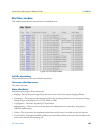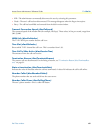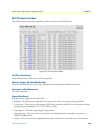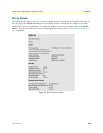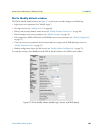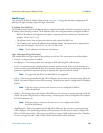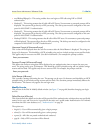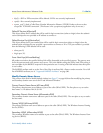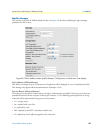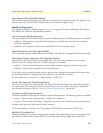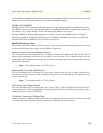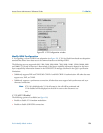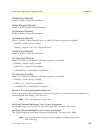
Dial In Modify default window 68
Access Server Administrators’ Reference Guide 7 • Dial In
• textORchapORpap(6)—This setting enables clear text logins or PPP calls using PAP or CHAP
authentication.
• MschapV1 - This setting assumes that all calls will be PPP users. No username or password prompt will be
displayed. The system will go directly to PPP processing. The dial-up user must be configured on his com
-
puter for MS-CHAP V1 authentication
• MschapV2 - This setting assumes that all calls will be PPP users. No username or password prompt will be
displayed. The system will go directly to PPP processing. The dial-up user must be configured on his com
-
puter for MS-CHAP V2 authentication
• MschapV1ORV2 - This setting assumes that all calls will be PPP users. No username or password prompt
will be displayed. The system will go directly to PPP processing. The dial-up user must be configured on his
computer for MS-CHAP V1 OR V2 authentication
Username Prompt (diUsernamePrompt)
This is what will be displayed when the user first connects after the Initial Banner is displayed. The string can
be up to 39 characters. This should be a ASCII printable string and can include carriage returns and line feeds.
This applies only for text users not PPP. (See also Initial Banner.) For example the prompt could be:
Enter your username:
Password Prompt (diPasswordPrompt)
This defines the character string that will be displayed at user authentication time to request the users pass-
word. The string can be up to 39 characters. This should be a ASCII printable string and can include carriage
returns and line feeds. This applies only for text users not PPP. For example, the prompt could be:
Enter your password:
Initial Banner (diBanner)
This is usually a message welcoming the user. The message can be up to 39 characters and should be an ASCII
printable string. It can include carriage returns and line feeds. The username prompt immediately follows the
initial banner. This banner only appears for text login users.
Modify Service
This portion of the Dial In Modify default window (see figure 27 on page 66) describes changing user login
services.
Default Service (diService)
This object defines the default service that will be provided if the authentication technique does not specifically
name a service type, and if no service is specified in the static user’s profile under Authentication. For informa
-
tion about the static users database, see 5, “Authentication” on page 30.
The options are:
• rlogin(1)—User will be automatically given a rlogin prompt.
• telnet(2)—User will be automatically given a telnet prompt.
• tcpraw(3)—All 8 bits are passed unchecked and unaltered.
• ppp(4)—Only a PPP connection will be allowed.



